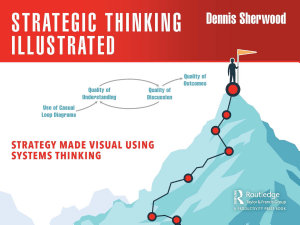Strategic Thinking Illustrated: Strategy Made Visual Using Systems Thinking
Meer oor hierdie e-boek
Some of the systems with which we interact are local, such as your organisation’s performance measurement system. Some systems, however, are distant, but nonetheless very real, such as the healthcare system, the education system, the legal system and the climate system. Systems, therefore, exist on all scales, from the local to the global. And all systems are complex, some hugely so. That’s why understanding how systems behave can be very helpful.
Systems are complex for two main reasons. First, the manner in which they behave over time can be very hard to anticipate – and anticipating the future sensibly is of course a key objective of management. Second, the ‘entities’ within a system can be connected together in very complex ways, so that an intervention ‘here’ can result in an effect ‘there’, perhaps a long time afterward. Sometimes this can be surprising, and so we talk of ‘unintended consequences’ – but this is of course a euphemism for ‘because I didn’t understand how this system behaves, I had not anticipated that’.
Systems thinking, the subject matter of this book, is the disciplined study of systems, and causal loop diagrams – the ‘pictures’ of this ‘picture book’ – are a very insightful way to represent the connectedness of the entities from which any system is composed, so taming that system’s complexity.
Meer oor die skrywer
Dennis Sherwood is currently the managing director of The Silver Bullet Machine Manufacturing Company Limited, specializing in creativity, innovation, and systems thinking.
His previous positions include:
-- Consulting Partner, Deloitte Haskins + Sells, and subsequently Coopers & Lybrand
-- Executive Director, Goldman Sachs
-- Managing Director, UK operations, SRI Consulting (Stanford Research Institute).
He has been using systems thinking since 1984 and is one of the UK’s leading experts.
He is the author of many journal articles, and their modern equivalent, blogs. In addition, he has authored 14 books on a variety of subjects, including systems thinking, creativity, innovation, and financial modelling.
He holds a degree from Cambridge (Natural Sciences, Part II Physics) as well as an MPhil from Yale (Molecular Biophysics and Biochemistry) and a Ph.D. from the University of California at San Diego (Biology). He is a Sloan Fellow (with distinction) of London Business School.






